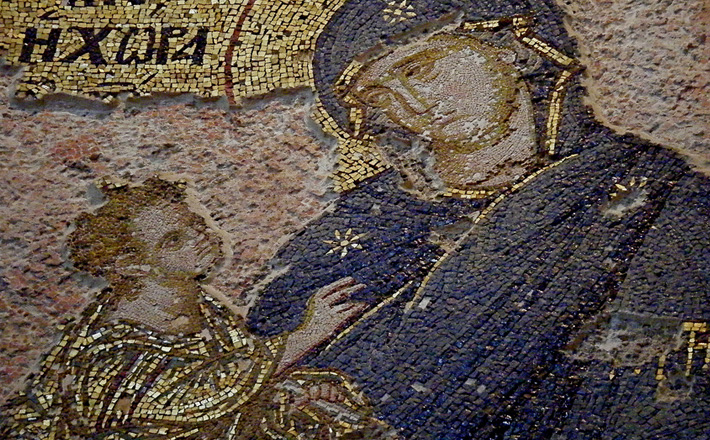Commentary on Luke 2:1-14 [15-20]
This text should carry a warning statement for those of us who dare to preach from it.1
The difficulty comes from the fact that this passage is one of the most familiar in all of scripture. So many know it, but so few actually know what it contains. Furthermore, most of the folks who come to worship and encounter this text already have in mind the blur of texts that we present in the Christmas play. To collide with this text and only this text will be an unexpected moment of gospel delight.
The first five verses set forth a historical background. This fits one of the stated purposes of this Gospel writer to “set an orderly account” (1:3). The problem is that the many difficulties with the historical reliability of these details make them disorderly. This should not be seen as a problem for Christmas Eve, however. The greater purpose of this first section is to point out the secular surroundings of this birth narrative.
A birth that can be most easily remembered in connection with a tax census–the counting of one person among hundreds of thousands–is initially represented simply as the birth of someone’s first born son. God may be breaking into the world, but there is no way to know that from the introductory verses. It may be important in our preaching to let that moment of revelation be delayed also.
Verses six and seven contain perhaps the most restrained, bare-boned birth narrative in all of history: “it happened while they were there that her term was up and the days were completed for her to deliver. She delivered her son, the firstborn. And she wrapped him up and placed him in a feed trough because there was no place of lodging for them anywhere else.”
It may be significant on this night to remind ourselves of what these verses tell us and what they don’t. There are details that must be important or Luke would not have included them in this bare-bones account. Take time to note these details in preparation for the preaching moment. Note also what is not in the text that we so often read into it (no snowy winter, no animals overlooking the baby’s crib, not even a stable, no innkeeper crying out “no room”).
Amidst all the excitement, excess, pageantry, and parading of people on Christmas Eve, we could not, at this point in the narrative, present a more contrasting humble and private event. This is not something to write home about. This is not a memorable event. It is, rather, a simple, straightforward, plain, account of a baby boy born in very humble surroundings. The child’s name is not even given.
Verses 8-14 do ramp up the excitement a bit. The news is delivered beyond the meager “birthing room.” To shepherds! The shepherds are in the region surrounding Bethlehem at night presumably doing what shepherds do–taking care of the sheep.
Making a somewhat spectacular appearance to the shepherds is an angel/messenger doing what an angel does–delivering a message. At the appearance of the angel, the shepherds respond with fear. The Greek at the end of the verse states this quite emphatically by using both the verb and the noun forms of the word translated in most versions as “fear.” This verse bears a second look.
The word translated as “fear” could also be translated as “reverence” or “respect.” In this sense, it has to do with “fear” of or “respect” of the deity. After all, this was an angel of the Lord. The angel’s response does not have to be read as: “Stop being afraid.” It may very well have the sense of “Stop reverencing me and listen to this message–it is not about me; something far greater has happened.”
This is a particularly rich way to approach the text when juxtaposed against the humble birth narrative which precedes this section. The angelic proclamation is where the “fanfare” seems to be. A heavenly chorus eventually sings to shepherds. That is the way we like Christmas Eve. But the initial angel says: “It is not about the side show or the way the message comes. It is the message itself.”
- One has been born
- For you
- In the city of David
- Today
- A savior
- Who is Christ the Lord
In order to validate the message, the messenger/angel then refers back to the details “we” have from verses six and seven and gives the shepherds permission to go find this infant for themselves.
Now the real show begins with the unexpected army of heavenly beings who are speaking a grand doxology to God and proclaiming peace in God’s name. No wonder we light candles and raise them in hymnic praise on Christmas Eve–the precedent was set, so to speak, on the shepherds’ fields so long ago.
I noted that there was no mention in the birth narrative proper (verses 6-7) of the name of the child. The child is named by the angel–Savior, Christ the Lord. Moreover, it is consistent with the child’s humble birth surroundings that these names are first given not to the highest strata of society but to common shepherds.
Though Luke’s Gospel sets this scene by dropping names of some of the best known people of the day (Emperor Augustus and Quirinius), the characters in this narrative are Mary and Joseph (an engaged, pregnant couple), homeless shepherds who lived in fields, an angel/messenger and a chorus of angels, and a newborn baby.
God was ready to enter the world and God did so in a most unconventional way. What a moment of gospel delight we can offer on Christmas Eve!
Notes
1. This commentary was first published on this site on Dec. 24, 2009.


December 24, 2016